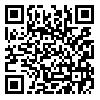Volume 18, Issue 118 (2021)
FSCT 2021, 18(118): 325-334 |
Back to browse issues page
Yasamin Latifi 
 1, Maryam Darvishhoseini2
1, Maryam Darvishhoseini2 
 , Ameneh Seddighi Pashaki3
, Ameneh Seddighi Pashaki3 
 , Zahra Ghafuri4
, Zahra Ghafuri4 
 , Leila Najafi5
, Leila Najafi5 
 , Atefeh Arjmandian6
, Atefeh Arjmandian6 

 1, Maryam Darvishhoseini2
1, Maryam Darvishhoseini2 
 , Ameneh Seddighi Pashaki3
, Ameneh Seddighi Pashaki3 
 , Zahra Ghafuri4
, Zahra Ghafuri4 
 , Leila Najafi5
, Leila Najafi5 
 , Atefeh Arjmandian6
, Atefeh Arjmandian6 
1- Young Researchers and elite Club, Noor Branch, Islamic Azad University, Mazandaran, Iran. , yasamin.latifi131@yahoo.com
2- Bachelor of food industry Engineer , Payame noor Qazvin center university, Qazvin, iran
3- Master of Food Engineering, Tehran University, Tehran, Iran
4- Phd student of hyginie and food quality control faculty of veterinary medicine department of governmental shahid Chamran ahvaz university Ahvaz-Iran
5- Agricultural Engineering and Food Science , Islamic Azad University, Lahijan Branch, Gilan, Iran
6- M.s.c. graguated, Department of Food Science and Technology, Islamic Azad University, Ayatollah amoli Branch, Mazandaran, Iran
2- Bachelor of food industry Engineer , Payame noor Qazvin center university, Qazvin, iran
3- Master of Food Engineering, Tehran University, Tehran, Iran
4- Phd student of hyginie and food quality control faculty of veterinary medicine department of governmental shahid Chamran ahvaz university Ahvaz-Iran
5- Agricultural Engineering and Food Science , Islamic Azad University, Lahijan Branch, Gilan, Iran
6- M.s.c. graguated, Department of Food Science and Technology, Islamic Azad University, Ayatollah amoli Branch, Mazandaran, Iran
Abstract: (1955 Views)
Citrus Lemon is one of the medicinal herbs that is cultivated mainly because of its alkaloids, nutritional properties and antioxidants. Lemon peel extract is rich in tocopherol, phenol, flavonoids and vitamin C, and has an antioxidant activity. The purpose of current study was to investigate the effect of solvent, microwave and ultrasound extraction on the antioxidant properties of sour lemon extract. The effects of different methods extraction such as soaking, microwave and ultrasound carried out using water: ethanol solvent (30:70) on amount extraction of tocopherol and phenolic compounds and antioxidant activity, and the study of colorless process of β-carotene-linoleic and the amount of vitamin C in extract of lemon peel to obtain the best extraction efficiency for proper use of the extract. And the antioxidant activity and the inhibitory effect of the linoleic acid oxidation of the extract were compared with synthetic antioxidant BHT. The results showed that the phenolic compounds (480 mg gallic acid/gram), tocopherol (145 mg/ml) and ascorbic acid (85 mg/100 g) in the ultrasonic extraction method had the highest content. Also, the percentage of free radical scavenging DPPH (91%) and the colorless process of β-carotene-linoleic (58%) in the extract extracted by ultrasound showed the highest percentage of inhibition, however, they had a lower percentage of inhibition compared to BHT. According to the results of this study, using an ultrasound method, an extract can be obtained that does not significantly differ with the antioxidant BHT level in terms of antioxidant activity.
Article Type: Original Research |
Subject:
Food quality control
Received: 2019/04/28 | Accepted: 2021/08/7 | Published: 2021/12/5
Received: 2019/04/28 | Accepted: 2021/08/7 | Published: 2021/12/5
| Rights and permissions | |
 |
This work is licensed under a Creative Commons Attribution-NonCommercial 4.0 International License. |


